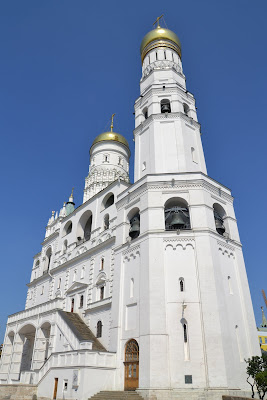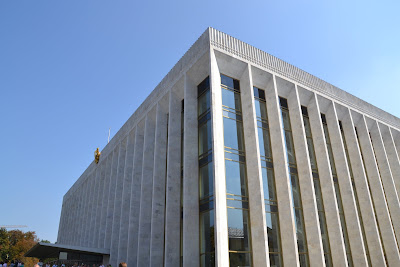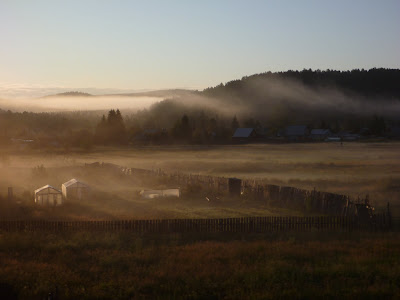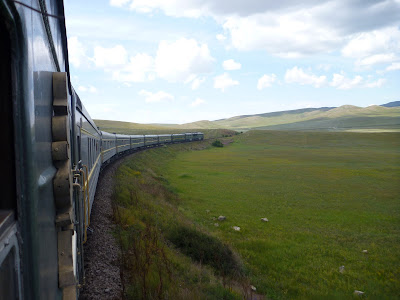ST. PETERSBURG
The Hermitage
After one last cramped but not altogether uncomfortable sleep on a Russian train, I arrived into St. Petersburg, the second largest and most "European" Russian city. Like most places on this trip I had little understanding as to what to expect; when I was younger, Leningrad as it was then known, was synonymous with the abject failure of communism in its aftermath with breadlines and unemployment the telltale signs of widespread poverty.
This image was pretty much immediately dashed
the moment I emerged from the incredibly deep subway (almost as beautiful as
the Moscow metro) onto Nevsky Prospekt, the most famous street in Russia, and
the heart of St. Petersburg. I tell you, this place does not look like
it's struggling for cash. There is some serious bling in this city.
Signs of an immensely wealthy past are everywhere, and make it easy to
appreciate that Russia was once the wealthiest of all the European monarchies a
few hundred years ago.
 |
| View from the Hermitage out onto Palace Square, with Alexander Column the focal point, built in celebration of the Russian victory over Napoleon in 1812. |
St. Petersburg is actually quite young having been founded only in 1703 by its namesake, Peter the Great. One might assume with a suffix of "the Great" he did some pretty cool stuff, and young Peter was indeed quite the legendary dude, particularly when you compare to him to many of Russia's less inspiring rulers. Peter was only 3rd or 4th in line for the throne as a boy, and as such he was not subjected to the same cotton wool protection afforded to his elder brothers. When a teenager he thus faced little resistance when he decided to essentially take a gap year/gap decade where he left the decidedly medieval environment of his homeland to explore the enlightened and progressive crowd over in Western Europe. Along his travels he acquired some 7-8 languages, spent time building ships in England, studied military history and tactics, and generally rubbed shoulders with influential statesmen from courts across the continent. By the time he returned to his homeland, he basically pushed aside his brothers and was determined to drag Russia into the 18th century from the dark ages.
One of his first moves was to take over
leadership of the army, and in quick time he managed to push the occupying
Swedes out of Northern Russia, and he determined that Russia needed to
establish a strong Navy and coastal fortress to protect it's interests from
those dominant Ikea folk to the west. And so he gave the order to build
St. Petersburg from scratch on the swampy mouth of the Neva River. Of
course thousands of forced labourers perished in the process of converting the
swamps into useable land, but Peter wouldn't be Russian without a fair share of
civilian suffering now would he? In any case they did a fine job as over
the next century St. Petersburg soon established itself as one of the most
beautiful cities in all of Europe, the "Venice of the North" with its
intricate series of canals linking the city.
Being a new city within a wealthy empire, it
aimed to show off the best of what Europe had to offer, and its cause was
helped by the widespread immigration of artists and intellectuals fleeing the
uncertainty caused by the French Revolution. Soon some of the world's
foremost composers, painters, and writers called St. Petersburg home and this
is clearly evident by the vast number of galleries, opera houses, ballet
companies, museums and theatres scattered throughout the city. If you
only have a few days in St. Petersburg these attractions tend to take up most
of your time, and topping the list is the world's largest art gallery, the
Hermitage.
The Hermitage is the former palace of Catherine
the Great (no relation technically to the other "The Great"... she
was actually German and took the throne when she killed her husband the king...)
She is still considered a hero in Russia though... pretty lenient towards their
leaders it seems. It has more wall space taken up by masterpieces than
any other gallery in the world, yet it only has one tenth of it's collection,
also the largest in the world, on display at any one time.
 |
| Matisse' priceless "The Dance" |
It's truly a marvel to walk past a wall full of Picasso, Monet or Matisse, but I swear the true work of art is the building itself. Catherine clearly believed she was deserving of the finer things in life and thank God for Royal budgets I say. Every room is a feast of craftsmanship, every corner full of precise and intricate detail, every object carved immaculately from timber, sculpted from marble or leafed with gold with skill that would be impossible to find in today's day and age. Truly a priceless wonder. Slightly ironic that the palace was so large when completed, that it become impossible to heat adequately during the frigid northern winters, so Catherine preferred to live in the more modest Winter palace next door.
 |
| One of the hundreds of stunning rooms throughout the Hermitage. |
Not all the galleries I visited were so awe-inspiring. Now I'm not an art aficionado but seriously some painters have got to be kidding themselves with some of their "art". I mean fair suck of the sauce bottle...
 |
| This title of this painting was "Red Square (Painterly Realism of a Peasant Woman in Two Dimensions)". Of course it is. Idiot. |
The architecture is truly beautiful throughout
the city and it’s a joy to just wander about crossing over the canals and
strolling through the extensive gardens throughout the city. One of the
highlights is the St. Basil-esque Church of the Saviour on Spilt Blood
cathedral, another tremendous example of the twisted lollipop architecture of
the Russian Orthodox Church. I found the story of this building
particularly fascinating as it was built to commemorate the spot where Czar
Alexander II was assassinated in 1881. I have always been amazed at how
the course of history can take momentous changes in direction due to the
actions of random individuals.
Alexander II was actually quite a visionary and under his rule had already emancipated the millions of Russian serfs and had drafted plans for a Duma, an elected assembly that would have given a voice to his subjects. Only two days (TWO DAYS!!) before he was due to implement this colossal change to Russian society, he was killed by terrorists (who ironically were actually campaigning for such a Duma) as he rode by in his carriage. His son Alexander III, fearful of a similar fate, abandoned the Duma and cracked down more harshly than ever on his subjects, sowing the seeds of resentment that eventually led to the popular uprising of the communist revolution. What would the world be like had Russia implemented such changes? Imagine if the Russian peasants had been given a voice? Would they have listened to Lenin when his train came laden with gold from Germany? The world may have been a very different place...
 |
| Church of the Saviour on Spilt Blood |
Alexander II was actually quite a visionary and under his rule had already emancipated the millions of Russian serfs and had drafted plans for a Duma, an elected assembly that would have given a voice to his subjects. Only two days (TWO DAYS!!) before he was due to implement this colossal change to Russian society, he was killed by terrorists (who ironically were actually campaigning for such a Duma) as he rode by in his carriage. His son Alexander III, fearful of a similar fate, abandoned the Duma and cracked down more harshly than ever on his subjects, sowing the seeds of resentment that eventually led to the popular uprising of the communist revolution. What would the world be like had Russia implemented such changes? Imagine if the Russian peasants had been given a voice? Would they have listened to Lenin when his train came laden with gold from Germany? The world may have been a very different place...
 |
| A wide array of museums are at your disposal in St. Petersburg... Imperial Bicycles, or playing cards anyone? |
Being in St. Petersburg in summer really is a pretty special experience as the weather is wonderful, the days incredibly long, the spectacular gardens are in bloom, cultural events are going on everywhere, and basically everybody's happy. Some of the highlights for me were the Petroghof garden's, the grounds of Peter's summer palace, and watching films on the canal's bridges (which are raised every night for the extensive river traffic) when the streets closed off for a huge street party of music and dancing.
Alas, I was only there for a short time, but I
couldn't leave Russia without experiencing a banya, which is basically a sauna
where you get whipped with those ubiquitous birch tree leaves. It was a
perfect way to spend my last night in Russia, as it provided a neat little
summary of my whole Trans-Siberian experience... I had little clue of what was
going on, it was mildly uncomfortable yet not entirely unpleasant, with
extensive amounts vodka and birch trees, wielded by aggressive-passive, if not
openly hostile near naked Russian men, and although I'll probably never do it
again, I'm glad I experienced it. Unfortunately the similarities ended
there, as I saw a lot of boobs in that banya...
On to Europe...









































